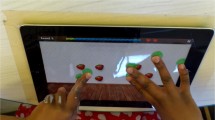Abstract
In this paper, we investigate the mathematical, social and affective nature of children’s engagement with TouchCounts, a multitouch application for counting and doing arithmetic. In order to study these dimensions of engagement in a way that recognizes their fundamental intertwinement, we use rhythm as a primary unit of analysis. Drawing on over 8 hours of research sessions with children aged 6, 7 and 8 years old, we show how various rhythms emerged from their interactions and how these rhythms changed over time—moving from the particular to the more general. We also show how important rhythm is to children’s carrying of activity, which relates to aspects of interest and motivation.





Similar content being viewed by others
Notes
TouchCounts is available for free in the App Store. See www.touchcounts.ca for a full description of its design and functionality.
References
Barad, K. (2007). Meeting the universe halfway: Quantum physics and the entanglement of matter and meaning. Durham: Duke University Press.
Bautista, A., & Roth, W.-M. (2012). The incarnate rhythm of geometrical knowing. The Journal of Mathematical Behavior, 31, 91–104. doi:10.1016/j.jmathb.2011. 09.003.
de Freitas, E., & Sinclair, N. (2014). Mathematics and the body: Material entanglements in the classroom. New York: Cambridge University Press.
Di Sessa, A. (2000). Changing minds: Computers, learning, and literacy. Cambridge: MIT Press.
Ingold, T. (2011). Being alive: Essays on movement, knowledge and description. London: Routledge.
Ingold, T. (2013). Making: Anthropology, archeology, art and architecture. London: Routledge.
Jackiw, N. (2006). Mechanism and magic in the psychology of dynamic geometry. In N. Sinclair, W. Higginson, & D. Pimm (Eds.), Mathematics and the aesthetic: new approaches to an ancient affinity. Heidelberg: Springer Verlag.
Lakoff, G., & Núñez, R. (2000). Where mathematics comes from: How the embodied mind brings mathematics into being. New York: Basic Books.
Papert, S. (1980). Mindstorms: Children, computers and powerful ideas. New York: Basic Books.
Radford, L., Bardini, C., & Sabena, C. (2007). Perceiving the general. The multi-semiotic dimension of students’ algebraic activity. Journal for Research in Mathematics Education, 28(5), 507–530.
Roth, W.-M. (2011). Geometry as objective science in elementary classrooms: Mathematics in the flesh. New York: Routledge.
Rotman, B. (2003). Will the digital computer transform classical mathematics? Philosophical Transactions of the Royal Society of London , A361, 1675–1690.
Sheets-Johnstone, M. (2009). Animation: The fundamental, essential, and properly descriptive concept. Continental Philosophy Review, 42, 375–400.
Sinclair, N. & Jackiw, N. (2014). TouchCounts [software application for the iPad]. https://itunes.apple.com/ca/app/touchcounts/id897302197?mt=8
Sinclair, N., & Pimm, D. (2015). Whatever be their number. In M. Meletiou-Mavrotheris, K. Mavrou, & E. Paparistodemou (Eds.), Integrating touch-enabled and mobile devices into contemporary mathematics education. Hershey: IGI Global.
Sinclair, N., de Freitas, E., & Ferrara, F. (2013). Virtual encounters: the murky and furtive world of mathematical inventiveness. ZDM – The International Journal on Mathematics Education, 45(2), 239–252.
Staats, S. (2008). Poetric lines in mathematical discourse: a method from linguistic anthropology. For The Learning of Mathematics, 28(2), 26–32.
Author information
Authors and Affiliations
Corresponding author
Rights and permissions
About this article
Cite this article
Sinclair, N., Chorney, S. & Rodney, S. Rhythm in number: exploring the affective, social and mathematical dimensions of using TouchCounts . Math Ed Res J 28, 31–51 (2016). https://doi.org/10.1007/s13394-015-0154-y
Received:
Revised:
Accepted:
Published:
Issue Date:
DOI: https://doi.org/10.1007/s13394-015-0154-y




